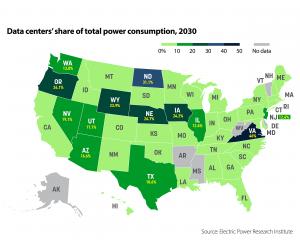
Report: AI data centers could drive up consumer electricity prices 70% by 2029
Average household could pay $1,200 more each year and be at risk of widespread brownouts and blackouts
“As data center expansion accelerates, consumers and small businesses are likely to bear the brunt of the consequences through higher electricity costs and brownouts and blackouts across the country,” said Ike Brannon, co-author of the study and a senior fellow at the Jack Kemp Foundation. “The average American household could pay over a thousand dollars more each year for electricity by the end of the decade if we don’t take urgent steps to resolve these energy shortages.”
The rise of AI technology is spurring unprecedented growth in data centers, which are essential for processing and storing massive amounts of information, according to the report. However, these data centers are extremely energy-intensive, placing an enormous strain on the nation’s electricity grid. A ChatGPT AI query requires about 10 times the amount of power as compared to a standard Google search; other AI resources can be even more energy intensive.
The report, “The Impact of Data Centers on Energy Demand and Market Prices,” was published by the Social Science Research Network.
“Small businesses, already grappling with inflationary pressures, may be forced to scale back operations, reduce staffing, or even shutter entirely,” Brannon said.
The research examines potential electricity shortages in Northern Virginia—a case study in the region with the highest concentration of data centers. As other regions race to build new data centers, these impacts could spread across the country, impacting millions of Americans.
Other research from the Electric Power Research Institute shows that data centers are using an increasing amount of total electricity available. In Virginia, data centers could use almost half of the total electricity by 2030. Similarly, North Dakota’s data centers could claim 31% of the state’s electricity supply, while Nebraska, Iowa, and Wyoming could see up to 24% of their electricity go toward these energy-intensive facilities. Nevada, Utah, Arizona, Washington, Illinois, New Jersey, and Texas could cede as much as 20% of their electricity to data centers by 2030.
“Policymakers must take immediate steps to shield consumers and small businesses from the negative impacts of rapidly-rising energy demand,” Brannon said.
To accommodate the need for much more electric power while protecting consumers, the report puts forth several policy recommendations:
Easing Permitting for Electricity Generation and Transmission: States and localities should streamline permitting processes to allow for faster construction of new electricity generation and transmission infrastructure.
Holding AI Data Centers Accountable for Higher Costs: Rather than shifting the financial burden on households and small businesses, AI data centers should be required to bear the additional costs of the energy they consume. This could include charging data centers higher fees to reflect their disproportionate impact on electricity markets.
Encouraging Energy Efficiency: Data centers and other high-usage energy consumers that implement significant energy-saving measures could qualify for a reduced tax rate incentivizing sustainable practices.
Limiting Data Center Subsidies: State and local governments should reconsider the use of subsidies to encourage the construction of data centers, especially in light of their limited job creation and minimal local economic benefits. Thirty-two states have given subsidies to data centers, including Virginia, which has granted $605 million in tax incentives to data centers since 2017. But research has shown these data centers create few real jobs and often cost taxpayers more than these jobs pay in wages. Redirecting resources to more sustainable economic drivers could benefit local communities while reducing strain on energy grids.
Addressing Transmission Costs: Data centers should contribute a larger share of the costs associated with new transmission hookups. Given their disproportionate use of electricity, AI companies should help offset the burden on consumers by funding improvements to the grid’s transmission capacity.
Carlton Carroll
Lamont Street
+1 850-445-0988
carlton.carroll@lamontst.net
Distribution channels: Business & Economy, Energy Industry, Environment, Technology, U.S. Politics
Legal Disclaimer:
EIN Presswire provides this news content "as is" without warranty of any kind. We do not accept any responsibility or liability for the accuracy, content, images, videos, licenses, completeness, legality, or reliability of the information contained in this article. If you have any complaints or copyright issues related to this article, kindly contact the author above.
Submit your press release
